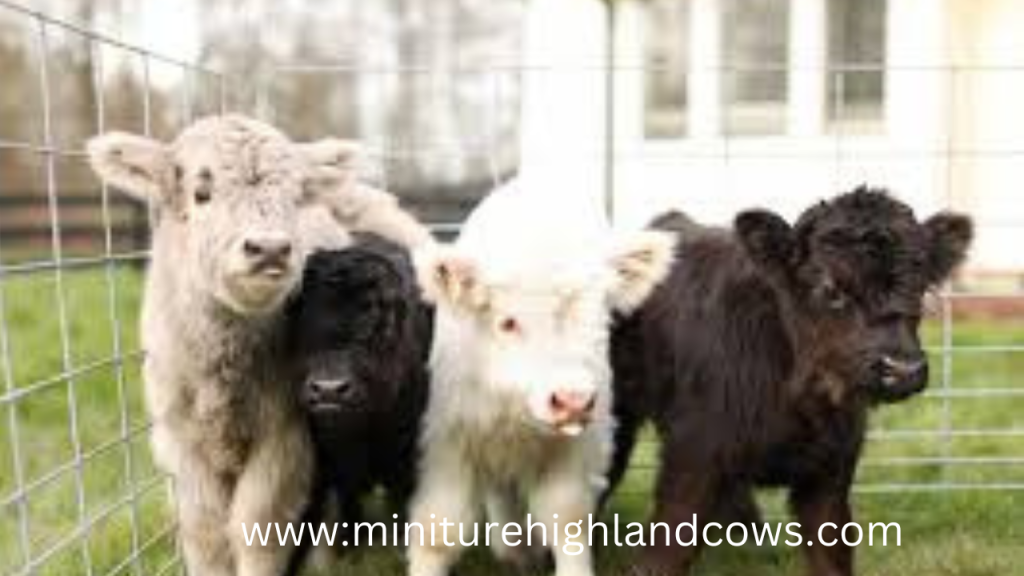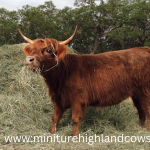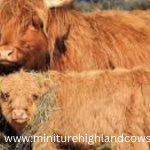So right, the miniature Highland cow does exist and is increasingly being farmed at small farms and animal raisers. Miniature Highland cows are selectively bred from full-sized Highland cattle such that they still retain all the attributes of the original ones but at the same time having been bred to be much smaller in size. They are loved for their whole package of being adorable and also practical for small farm settings.

Are miniature highland cows real or fake
Miniature Highland cows do exist. They are selected to be miniature representations of the traditional Highland cattle of Scotland. They retain all the defining characteristics – their shaggy coats, their impressive and long horns, and sturdy build – but are significantly smaller than their parent, thus appealing to many small-scale farmers, homesteaders, and animal enthusiasts.
Miniature Highland cows, for instance, can grow as low as 36 inches at the shoulder and up to full-sized Highland cows with a range of 48-52 inches. Such manageable sizes, coupled with their gentle temperament and low maintenance needs, make them very attractive to those who have limited space yet want to enjoy the unique charm of Highland cattle.
Are miniature highland cows real or fake 2021
Yes, miniature Highland cows were real and gaining popularity by 2021! These smaller cousins of the traditional Highland cattle are selectively bred to be more compact but to maintain the classic look of the breed—thick, shaggy coats, long horns, and a sturdy build.
A small Highland is around 36-42 inches in height at the shoulder. Full-sized Highlands can be up to 48 inches or more. The smaller size has made miniatures suitable for hobby farms, homesteads, and people having limited space. On social media and agritourism industries, their nature and their appearance made them even more popular because of their easy-going nature.
About micro mini highland cow
They are smaller than the miniature Highland cattle but bred to be very compact, with the looks of the common Highland cattle-thick and shaggy coats, long horns, and sturdy, friendly personalities. Micro mini cows usually stand under 36 inches at the shoulder, although some are even closer to 30 inches or less.

Characteristics
Micro mini Highland cows are bred specifically for their small size and represent, in many cases, a significant number of generations of selective breeding. Their double coat protects them well in colder climates and calms their gentle nature, offering a breed that is relatively easy to handle and care for, appealing to the small-scale farm or hobbyist, but also offering a unique opportunity for the owner who wishes to have a pet on a small plot of land.
Practically, the micro mini Highland cows are a trend recently, especially through social media, as their small size and fluffy coats just win hearts. They require less space and feed compared to full-sized cattle. With the protective double coat, they can also thrive in different types of climates.
Cost and Availability
Micro mini Highland cows are usually pretty expensive because of the high demand, and it takes such animals a long time to breed in order to keep their small size. Careful breeding guarantees them health and retention of Highland features. Such animals can be scarce because of the meager number of reputable breeders. Potential buyers should research the breeders properly so that they avoid unethical practices.
To cut a long story short, micro mini Highland cows are the real deal and have gained popularity because they can easily be handled and pretty cute-looking. They would be among the most desirable additions to farms, homesteads, and even some homes, where they are considered lovely pets.

Characteristics of Miniature Highland Cows
Miniature Highland cows look similar to their full-size counterparts but stand relatively at just half of the size. A normal cow usually measures around 3.8 to 4.5 feet tall at the shoulder and weighs between 1,100 and 1,800 pounds. Miniature Highlands usually measure about 3 feet at the shoulder and weigh around 500 to 700 pounds. Although they are smaller in size, they still retain the classic features of Highlands, such as long, typical horns and heavy, woolly coats that help the cattle survive the toughest climatic conditions.
One of the most distinguishing features of Highland cattle is their double-layered coat. This coat makes them survive in the coldest environments because it keeps them warm due to its insulating effect on the body. The undercoat of such a creature is soft and downy; the outer coat is long, oily, and water-resistant. Miniature Highlands, just like regular Highlands, have much the same coat construction, which makes them pretty hardy animals that require little in the way of shelter-at all in comparison to most cattle breeds. That’s why they do so well in such a wide variety of climates, even some pretty cold winters.
Practical Benefits
These little Scottish Highland cows become wanted and highly wonderful choices for the small farm, homestead, or even hobby farm because they are pretty manageable in size. They are smaller in size and are not as space- and feed-hungry as traditional-sized cows, which makes them a sustainable choice for people with limited land. Their smaller size also makes handling and caring relatively easier, and thus new or hobbyist farmers have an infinitely easier time in the care of their animals. While they do require some basic maintenance, they are generally low-maintenance animals and can often thrive on some of the rougher terrain or land that might not be ideal for other types of livestock.
Miniature Highland cows are also friendly and docile to work with. They are very calm by nature, thus making them a good pet or companion. They are popular in nature and especially become a favorite on agritourism farms where visitors can get a glimpse of them and enjoy their unique looks and gentle nature.
Demand and Popularity
Miniature Highland cows have become a hot favorite with interest in sustainable farming going up. With their minuscule size and less resource requirement needs, they are more environment-friendly than typical livestock. This breed has also become a craze on social media platforms with their cute faces and very long fur-they’ve stolen hearts all over the world.
However, demand for miniature Highland cows makes them relatively rare, and they tend to be more expensive than standard-sized Highlands or even any cattle breeds. Breeding is not quite direct; careful selection has to be done to retain their specialty characteristics while reducing their size. Therefore, proper breeders take time to produce quality stock.
Conclusion: Miniature Highland cows exist; it is a mix between practical usefulness, charm, and eco-friendliness that makes them great to have on the smallest of farms, hobby farms, or as a special manageable livestock animal for families.










